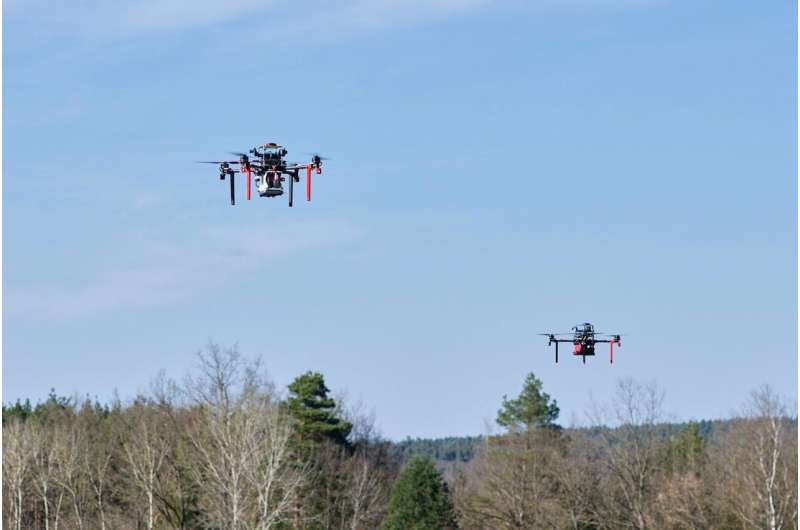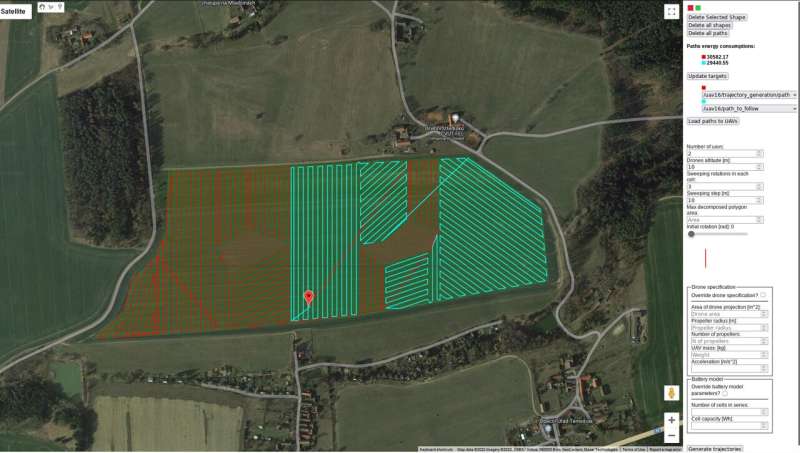March 22, 2024 feature
This article has been reviewed according to Science X's editorial process and policies. Editors have highlighted the following attributes while ensuring the content's credibility:
fact-checked
peer-reviewed publication
trusted source
proofread
A method to enhance the planning of missions completed by multiple UAVs

Unmanned aerial vehicles (UAVs), also known as drones, have already proved to be valuable tools for tackling a wide range of real-world problems, ranging from the monitoring of natural environments and agricultural plots to search and rescue missions and the filming of movie scenes from above. So far, most of these problems have been tackled using one drone at a time, rather than teams of multiple autonomous or semi-autonomous UAVs.
Compared to individual UAVs, UAV teams could cover wider geographical areas, capturing more footage of specific scenes or completing desired missions faster. Many roboticists and computer scientists have thus been working on new technologies that could facilitate the simultaneous deployment and coordination of multiple UAVs.
Researchers at Czech Technical University in Prague recently introduced a new method to plan minimum-energy paths for UAVs in a team, allowing them to efficiently cover environments as a team during missions. This method, introduced in IEEE Robotics and Automation Letters, could both minimize the energy consumption of UAV teams, considering the battery capacity of drones when planning their paths and optimize the speed of flight.
"Our recent paper was inspired by our previous research efforts in planning algorithms for single-UAV coverage path planning and multi-UAV inspection planning," František Nekovář, co-author of the paper, told Tech Xplore. "Coverage tasks over large outdoor areas require the use of multiple UAVs due to their limited flight times and battery capacity. However, existing multi-UAV planning approaches did not account for energy constraints directly, optimizing for flight time or traveled distance instead."
The key goal of the recent work by Nekovář and his colleagues was to develop a new computational model that would coordinate the actions of multiple UAV, enabling the energy-aware coverage of environments during missions. In contrast with many other UAV team planning frameworks introduced in the past, their proposed approach considers the optimal flight speeds of UAVs in a team and their individual battery constraints.
"Our approach works by first decomposing the area into cells using a boustrophedon decomposition," Nekovář explained. "We then plan back-and-forth sweeping patterns within each cell to cover it, utilizing the optimal flight speed to minimize energy consumption per distance.

To effectively allocate cells to individual UAVs in a team and plan their plans and actions, such as what locations they will visit and in what order, the researchers formulated the mission as a multiple set traveling salesman problem (MS-TSP). This is a mathematical problem that describes a scenario in which a group of salesmen need to visit a number of cities grouped in sets, visiting each set only once and then returning to their starting location at a minimal cost of travel.
"We tackled this problem using a meta-heuristic solver," Nekovář said. "During planning, fast energy estimation algorithm along with optimal speeds are used to minimize total energy consumption while meeting battery constraints. The energy-aware planning and use of optimal speeds are the key unique aspects compared to prior work."
The researchers evaluated their approach both in simulations and in a real-world experiment, where they deployed it on a team of drones tasked with monitoring a set geographical area. Notably, their approach was found to outperform previous approaches in terms of both coverage speed and energy consumption, reducing the energy spent by the drones by up to 40.4%.
"We have verified our energy estimation is on average 97% accurate to the values measured in flight," Nekovář said. "In a field experiment, we demonstrated feasibility of our planning approach with two UAVs covering an area in coordination."
In the future, the new approach introduced in this recent study could facilitate the use of UAV teams in real-world settings, particularly for tackling tasks that require longer flight times, such as the inspection of infrastructure, precision agriculture and environmental monitoring. Nekovář and his colleagues published its underlying code on GitHub, so other researchers could soon also implement and test their method in specific settings.
In their next studies, the researchers plan to further develop their approach, also allowing it to plan UAV coverage in 3D and incorporating localization uncertainty. They also wish to include the possibility of recharging individual UAVs during missions and swapping them with fully charged systems, as this would further extend the team's overall battery lifespan and enable their use for tackling longer missions.
"Integration of perception and mapping capabilities will also enable fully autonomous coverage missions with obstacle avoidance and surface reconstruction," Nekovář added. "Furthermore, we plan on adding replanning capabilities, which improve the ability of our method to handle unexpected scenarios with dynamic obstacles or battery issues.
"Overall, extending our energy-aware planning approach to enable long-endurance and safe multi-UAV operations is an exciting direction for future research."
More information: Denys Datsko et al, Energy-Aware Multi-UAV Coverage Mission Planning With Optimal Speed of Flight, IEEE Robotics and Automation Letters (2024). DOI: 10.1109/LRA.2024.3358581. On arXiv: DOI: 10.48550/arxiv.2402.10529
© 2024 Science X Network

















